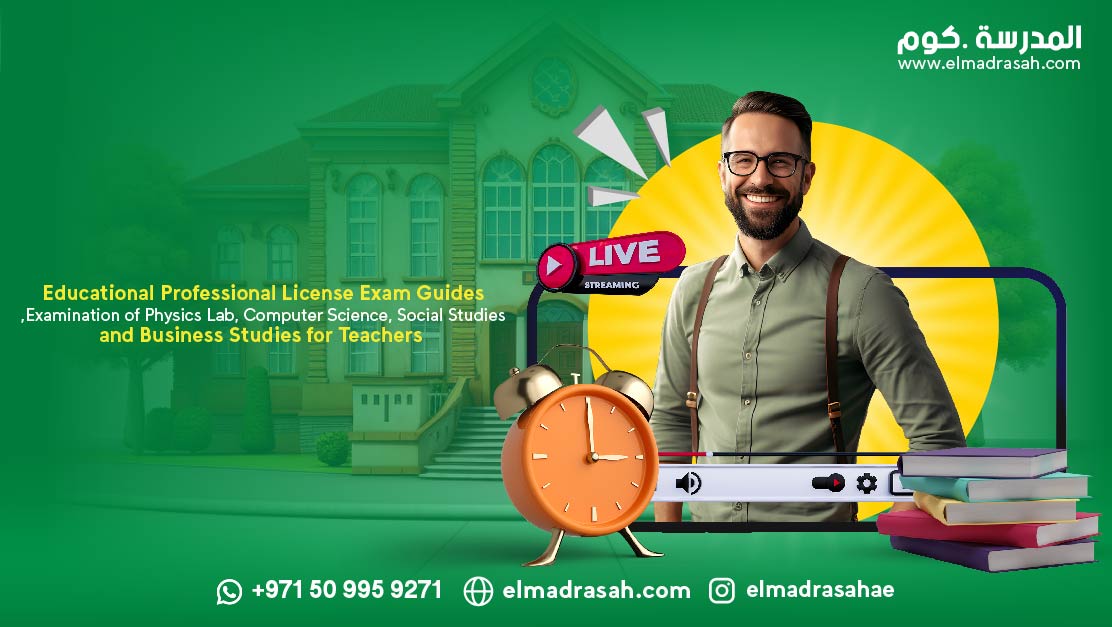
The launch of training versions for teacher licensing tests is an important development in the Educational Professional License System, as the Ministry of Education aims through this to develop the competence of teachers and better qualify them to face the challenges of the educational process in the twenty-first century. These experimental tests come as an important step to ensure access to On high-quality teaching and effective evaluation of teachers’ performance in the classroom.
Teaching tests in the Educational Professional License System
Teaching exams play a vital role in the teaching professions licensing system, as they are considered:
- An effective way to evaluate teachers’ skills and their ability to deliver information in innovative and effective educational ways.
- In addition, these tests contribute to developing teachers’ skills and motivating them to explore new and innovative teaching methods.
- These tests also provide specific teaching tools for teachers and provide instructions and guidance to improve their educational performance.
- The test also aims to measure teachers’ knowledge of the components of education and their ability to apply them in the classroom.
- The test is presented objectively and professionally to ensure a fair and accurate evaluation of teachers. Based on the test results, training and development programs are directed to improve the educational and professional capabilities of teachers.
- Tests are also an opportunity for teachers to evaluate and improve their performance. By noting the strengths and weaknesses of their work, teachers can identify areas they need to improve and take action to develop themselves.
- Passing the school careers test also provides better opportunities for teachers to obtain career opportunities in the educational field.
Testing is not the end of learning and development, but rather the beginning of the journey of continuing professional learning and achieving continuous improvement in teaching skills and positively impacting students and developing their education.
Tests of the Educational Professional License System for teachers in the physics laboratory
Laboratory tests in the field of physics are considered an important tool for evaluating teachers’ skills in teaching this subject. The teacher must have high skills in analysis and experimentation, and the ability to guide students and explain physical phenomena in an easy and clear way. This test contributes to motivating teachers to improve their teaching methods and innovate new methods to deliver information more effectively. This test also helps in identifying the strengths and weaknesses of teachers, and thus training and development programs can be directed to enhance their abilities in teaching physics. This test includes three axes:
The first axis: Safety and emergencies
The test taker must possess the knowledge and skills necessary to perform a range of laboratory-related activities following safety rules:
- Student safety before and after class.
- Create a safe work environment and reduce the risk of work-related accidents, injuries, and illnesses.
- Know how to store and dispose of hazardous materials correctly.
- Dealing with fires and power outages.
The second axis is procedural knowledge
The test taker must possess:
- Keep the place clean.
- Dealing with all equipment and how to maintain it.
- Select and use appropriate materials and equipment.
- Use mathematical methods of counting, measuring, and arithmetic to solve problems.
- Analyzing and interpreting scientific data.
- Identify and analyze errors.
- Knowledge of units of measurement and dimensional analysis.
The third axis: conceptual knowledge
Enhancing scientific skills as the test taker possesses:
- Deep knowledge of the mechanical, electrical, magnetic, optical, acoustic, thermal, atomic and nuclear properties of materials.
- Knowledge of Newtonian mechanics for point bodies and extended bodies, including mechanics, dynamics, work, energy, and momentum
- Collisions, orbits, gravity, balance, and elasticity.
- Magnetic and electrical forces.
- Statics, and other branches of physics related to the physics curriculum for all levels.
Exams for Educational Professional License System of computer science
Computer science tests in the Educational Professional License System play an important role in developing the skills of teachers specialized in the field of computing. Through these tests, the teacher’s abilities to understand and apply computer concepts and techniques in the learning process are evaluated. The test also contributes to raising the level of technology awareness among teachers and developing their abilities to use technology in teaching and apply it to various educational fields. In addition, this test contributes to identifying the strengths and weaknesses of teachers and directing training and development programs to enhance their capabilities in the field of computing and improve their teaching methods. The test includes the following topics:
The first axis: computer science theory
This section tests examinees’ knowledge in major theoretical areas of computer science such as computer systems and networks, data analysis, and computing effects. In this section, the examinee must be able to:
- Identify the hardware and software of computing systems and their interactions and apply troubleshooting strategies to basic hardware and software problems.
- Design computer networks based on specific network design requirements and describe the network organization in terms of hardware and software components and network security.
- Explain how computer network hosts communicate with each other within one network and with other networks and describe how data is transferred across networks in terms of speed, security, and privacy.
- Use data collection methods to collect, store, and analyze different types of data and identify patterns in them.
- Representing data in computers using the binary numbering system and using digital tools to create simulations and models and represent different types of data visually.
- Describe the ethical and legal use of technology and explain the consequences of irresponsible use of technology.
- Identify the impact of technology on people’s personal, social and professional lives and describe the consequences of the digital divide.
The second axis: problem solving and programming practices
This section of the Educational Professional License System tests the examinee’s knowledge and skills in problem-solving techniques. This section of the test is presented in three programming languages: Python, JAVA, and C++, and examinees are allowed to choose their preferred programming language. This section tests whether the examinee is able to:
- Use programming skills as a tool to solve computational problems.
- Design and evaluate algorithms based on established design specifications and apply the pillars of computational thinking (abstraction, analysis, pattern recognition, and generalization) as problem-solving techniques.
- Identify appropriate variables for program data and decide whether using individual variables or data structures is more effective based on the nature of the program.
- Knowledge of programming using different programming paradigms (method) such as procedure-oriented programming (POP), block-based programming (BBP), and object-oriented programming (OOP).
- Select appropriate control structures and control structure conditions to control the flow of the program as intended in the program design specifications.
- Build programs based on specific program design specifications by applying the steps of the programming development cycle.
Social studies tests for Educational Professional License System
Social studies tests are an important part of the teaching professions licensing system in education. The test aims to measure teachers’ knowledge of social studies concepts and their ability to communicate them to students in effective and innovative ways. The test also helps determine the extent of teachers’ efficiency in applying social education standards in practical life. The test also contributes to developing teachers’ skills in planning lessons, evaluating students, and encouraging their critical and analytical thinking in the field of social studies.
The examination standards for licenses for teaching professions in the field of social studies include developing teachers’ skills in practical work. This includes:
- Their knowledge of events and ideological and technological developments from ancient history to the classical period, the golden age of Islamic civilization, from the Middle Ages to pre-colonialism, the industrial revolution and colonial expansion, and the modern era.
- National education and social responsibilities are the responsibilities of citizens in the United Arab Emirates, and the rights and duties of citizens and residents there.
- Knowledge of the constitution, governance structures and the role of federal institutions.
- Know the role of United Nations agencies and international institutions
- Knowledge of the country’s natural characteristics of land, soil, water characteristics and weather.
- Knowing the impact of human resources on humans and the impact of the environment on human settlement.
- Knowledge of sociology, population migration, its causes, and factors of social transformation.
- Knowledge of economics, what is micro and macro economics, markets and economic systems.
- Information literacy, obtaining digital information, collecting and processing data.
- Know the importance of an ethical environment of tolerance, compassion, justice and fairness.
- Commitment to customs and traditions and knowledge of the culture and heritage of the United Arab Emirates.
- Integration, interpretation and dealing with social sciences.
Business study tests in the Educational Professional License System
Business studies examination plays an important role in qualifying teachers to teach business subjects in schools. The test also helps determine the teacher’s level of proficiency in using modern business teaching tools and techniques. Based on the test results, training and development programs are directed to enhance teacher skills and improve business teaching methods. In addition, the test contributes to enhancing the teacher’s awareness of the importance of business subjects in developing students’ abilities and preparing them for the future labor market.
The Business Studies test includes a variety of content intended to assess a teacher’s knowledge of business and economics topics. Content includes questions about:
The first axis: Finance and accounting
This area tests the examinee’s knowledge and understanding:
- Ability to set well-thought-out financial goals. How goals are used by a business to achieve its set goals.
- Knowledge of principles and terminology associated with financial management and business accounting.
- Evaluating financial operations in fundraising and management, and measuring business performance.
- An understanding of ethical decision-making processes in order to improve financial performance.
- Evaluation of the accounting cycle, accounting processes, and regulating accounting principles (RAP).
- Interprets Statements of Standard Accounting Practice (SSAP) and use of financial statements.
- Analyze and calculate profitability ratios to evaluate business performance.
- They explain the purpose of different budgets (such as, but not limited to, zero-sum budgets and previous numbers budgets).
- Ratio analysis and financial performance.
- The concept of profit in relation to financial management.
- Demonstrates an understanding of systems and concepts related to credit, taxes, and bankruptcy.
- Evaluating financial decisions in finding financing and evaluating credit performance.
The second axis: managing operations in the examinations of the educational professions licensing system for studying business, which includes:
- Understand the nature and extent of operations and principles of business management.
- Analyzes business operations within performance objectives of quality, costs, responsiveness, flexibility, reliability and environmental factors.
- Define business economics under industry sector production classifications: primary, secondary and auxiliary.
- Knowledge of production methods, converting inputs into outputs.
- Demonstrates an understanding of the concepts, techniques, and philosophies used to improve and streamline production efficiency. Examples include Kaizen, Kanban, and Just in Time.
- Analyzes how information technology such as computer-aided design (CAD) and computer-aided manufacturing (CAM) are used by companies to improve productivity.
- Analyzes operational performance factors that affect labor productivity (such as, but not limited to) division of labor, motivation, technology, investment, skills, and workforce experience.
- Demonstrates how break-even analysis can support business planning processes.
- Recognizes the need for strategic implementation of project management in business operations.
- Applies the use of project analysis strategies and management tools such as but not limited to (network analysis and critical path analysis).
- Inventory control, and methods associated with operational decisions to improve performance.
- Distinguishes between efficiency, productivity and capacity utilization.
- Quality control and maintaining consistent levels of quality and its four standards.
Third axis: Marketing
Examiners in the educational professions licensing system must be able to:
- Knowledge of marketing objectives and the role of marketing in business management and achieving business objectives.
- Know the components of the marketing plan.
- How to identify the marketing mix of organizations.
- Familiar with the four elements of the organization’s marketing mix (product, price, promotion, place).
- Evaluate types of e-commerce and strategies for planning, developing and creating Internet-based businesses.
- An understanding of the procedures involved in designing, maintaining and managing an e-business website.
- Sales forecasting and marketing analysis.
- Knowledge of primary and secondary market research techniques and the distinction between qualitative and quantitative market research.
Fourth axis: Humans in business
The educational professions licensing system in this field tests the examinee’s knowledge and understanding of the following:
- How companies develop policies, use structures, systems and strategies related to people in business.
- Knowledge of HR objectives and differentiation between the components of the stakeholder and shareholder model in a business company.
- Determine how to classify business stakeholders and their respective roles.
- Determine the steps involved in starting a business.
- Types and characteristics of the different categories of business ownership, franchises and cooperatives.
- Know the advantages of private limited and public limited companies, the private sector, the public sector, and non-profit organizations.
- Know and analyze the factors that affect leadership style and management methods, skills and functions related to leadership style.
- Understand the importance of managing change effectively in business.
- Demonstrates an understanding of the factors influencing business decision making in relation to risk, uncertainty, investment criteria and non-financial factors.
- Identifies the different forms of flexible workforce planning practices including but not limited to (flexible working hours, working from home, part-time, temporary, and work sharing).
- Distinguishes between different training models such as on-the-job, off-the-job, and on-the-job apprenticeships.
- Knowledge of procedures related to employment, including but not limited to (selection, training, evaluation, and termination).
- Analyzing the quality of different communication methods, including but not limited to (applications, CVs, and job interview techniques).
- Knowledge of health and safety standards in the workplace.
- How to use evaluations in practice and as a strategic tool for performance evaluation.
The fifth axis: The external environment for business
The educational professions licensing system in this area tests the examinee’s knowledge and understanding of how the economy and external business environment affect business performance, and may include:
- Legal, economic, social, technological, environmental and ethical factors that may affect business activity.
- Knowing external and internal shocks and evaluating their effects on business practices.
- Evaluating the role of the public and private sectors in providing goods and services.
- Knowledge of the concept of market failure and the different types, including but not limited to (public good, external factors, hidden information, and common property).
- Know the characteristics of perfect competition, monopolistic competition, monopoly and oligopoly.
- Analyze different competition theories and their impact on business behavior.
- Determine the foundations, role and impact of international business.
- Identify the factors that contributed to globalization.
- The importance of global marketing and global brands.
- Understands how changes in demographics can impact the marketing of products and services.
- PEST and PESTLE analysis and international business environment factors.
- Explains comparative advantage and absolute advantage as they relate to international trade.
- Recognizes the value of exchange rates and can interpret and conduct foreign labor calculations.
- It analyzes information related to imports, exports, trade barriers, free trade, and the commerce balance.
- Know the role of national and international policies related to projects and commerce.
- Interprets and calculates the opportunity cost of capital.
- Demonstrates an understanding of economic influences (including but not limited to (consumer confidence, business confidence, interest rates, inflation, unemployment))
Teachers’ preparation for tests of Educational Professional License System
Teachers’ preparation for the tests of the educational professions licensing system plays an important role in achieving success and excellence in the teaching profession. Here are some tips for teachers to help them prepare for tests and increase their chances of success:
- Identify the test requirements: and explore its details.
- Prepare a study plan and identify the subjects and skills you need to focus on while studying.
- Use various educational sources to study subjects comprehensively.
- Solve past questions and practice to improve your abilities.
- Take preliminary exercises and tests to improve your solving and timing skills.
- Use available practice test websites and solve very similar questions.
- Benefit from feedback from teachers and peers and see it as an opportunity to learn and improve.
- Talk to teachers who have taken the test to get tips and strategies.
In short, teachers need to focus and prepare well for teaching tests. You can get all these preparations and practical applications with elmadrasah.com platform, and increase your chances of success in exams and achieving excellence in the Educational Professional License System.















